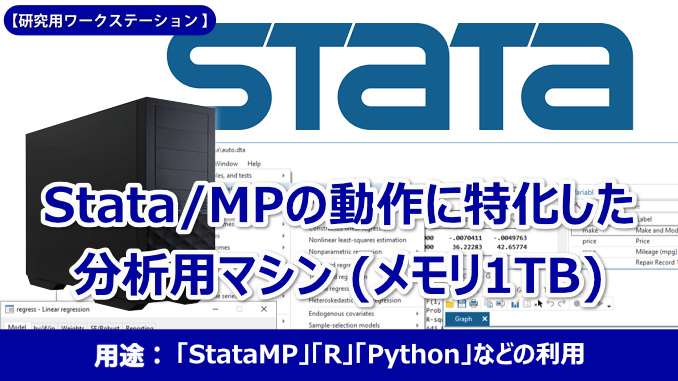

Case No.PC-9133BA customer who viewed this requested a machine for analyzing tax data with Stata/MP.
The data file of Stata/MP is about 170GB, and we would like to introduce a machine that can handle this large size file without problems with a budget of about 300 million yen.
More specifically, even if the number of variables handled by Stata/MP increases by about three times during program execution, and the required memory increases accordingly, we have received a condition that the specifications can handle without processing dropouts.
The machine specs that the customer is currently using are as follows.
|
・CPU: Core i5-8400 (2.8GHz 6 cores) |
You asked for 512GB of memory, but since data files of nearly 20GB are added every year, we would also like to have a proposal to ensure memory expandability.
Customers have also asked us, "I think it's better to use SSD for storage considering the memory overrun when dealing with Stata/MP, but if there's no particular need to consider it, please let me know." increase.
Based on the above conditions, we proposed the following configuration.
【Main Specifications】
| CPU | Xeon Gold 6326 (2.90GHz 16 cores) x2 |
| memory | 1TB REG ECC (64GB x16) |
| Storage 1 | 4TB M.2 SSD |
| Storage 2 | 16TB HDD S-ATA |
| video | Nvidia T400 |
| network | on board (1GbE x1 10GBase-T x1) |
| Housing + power supply | Tower type housing + 1000W |
| OS | Microsoft Windows 11 Pro 64 bit |
|
■ Points ・The CPU selection for the Stata machine depends on the number of cores contracted for the Stata license. |
Since the customer inquired after looking at the PC-9133B (32-core license specification configuration), we considered it assuming a 32-core contract.
Emphasizing memory capacity, it is a configuration that allows more memory modules to be installed by making it a 2 CPU configuration.
While securing a capacity of 1 TB in the initial state, it is possible to support up to 2 TB by replacing modules.
If the memory capacity is about 512 GB to 1 TB, or if CPU speed is a priorityPC-10746Aor sending us a message onPC-10746B.
For storage, the system side is a high-speed SSD in case the amount of data to be handled overflows from the memory.
However, due to the nature of SSD, there is a limit to the number of times it can be rewritten, so it is not recommended to use it on the premise of constant memory swapping.
Since speed and durability are affected by the amount of free space on the SSD, we select products with large capacity.However, instead of leaving the main data on this SSD, it is assumed that it will be used by moving it to the 16TB HDD side and saving it.
On the SSD side, enough free space is left to ensure sustain performance, so it is assumed that unnecessary data is not placed on the C drive as much as possible.
The configuration of this case study is based on the conditions given by the customer.
Please feel free to contact us even if you are considering different conditions from what is posted.
■FAQ・What is Stata reference:Been * Jump to our Unipos handling product page
・What is memory swap?
・What is sustain performance? |
|
■ Click here for details and inquiries about this PC case * Please enter the name of the case or your desired conditions. |







